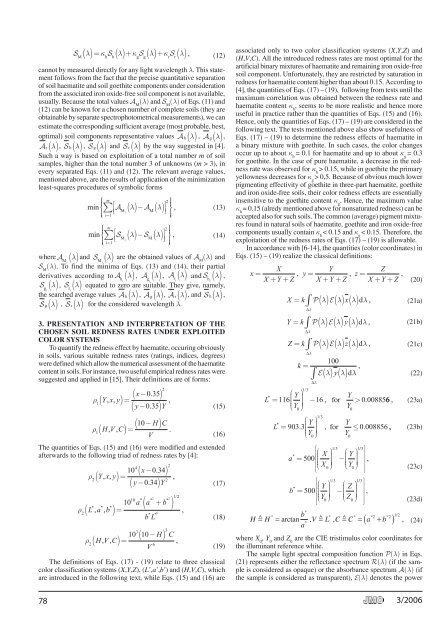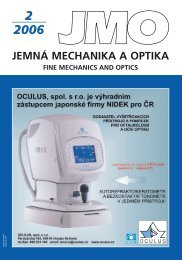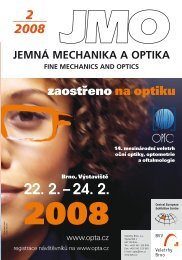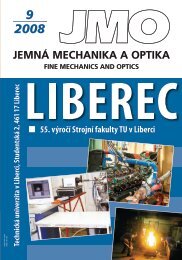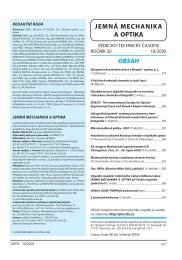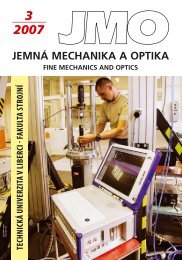You also want an ePaper? Increase the reach of your titles
YUMPU automatically turns print PDFs into web optimized ePapers that Google loves.
��<br />
( )= ( )+ ( )+ ( ),<br />
S λ κ S λ κ S λ κ S λ<br />
M h h g g r r<br />
(12)<br />
cannot by measured directly for any light wavelength λ. This statement<br />
follows from the fact that the precise quantitative separation<br />
of soil haematite and soil goethite components under consideration<br />
from the associated iron oxide-free soil component is not available,<br />
usually. Because the total values A (λ) and S (λ) of Eqs. (11) and<br />
M M<br />
(12) can be known for a chosen number of complete soils (they are<br />
obtainable by separate spectrophotometrical measurements), we can<br />
estimate the corresponding sufficient average (most probable, best,<br />
optimal) soil components representative values Ah ( λ),<br />
Ag ( λ),<br />
Ar ( λ),<br />
S h ( λ),<br />
S g ( λ)<br />
and S r ( λ)<br />
by the way suggested in [4].<br />
Such a way is based on exploitation of a total number m of soil<br />
samples, higher than the total number 3 of unknowns (m > 3), in<br />
every separated Eqs. (11) and (12). The relevant average values,<br />
mentioned above, are the results of application of the minimization<br />
least-squares procedures of symbolic forms<br />
⎧ m<br />
2<br />
min ⎨<br />
⎪ ⎡A<br />
λ A λ ,<br />
M ( )−<br />
i<br />
M ( ) ⎤<br />
⎫<br />
⎬<br />
⎪<br />
⎩<br />
⎪∑<br />
⎪<br />
⎣⎢<br />
⎦⎥<br />
i=<br />
1<br />
⎭<br />
⎪<br />
⎧ m<br />
2<br />
min ⎨<br />
⎪ ⎡S<br />
λ S λ ,<br />
M ( )−<br />
i<br />
M ( ) ⎤<br />
⎫<br />
⎬<br />
⎪<br />
⎩<br />
⎪∑<br />
⎪<br />
⎣⎢<br />
⎦⎥<br />
i=<br />
1<br />
⎭<br />
⎪<br />
(13)<br />
(14)<br />
where A ( λ)and<br />
S ( λ)<br />
are the obtained values of A (λ) and<br />
Mi<br />
Mi<br />
M<br />
S (λ). To find the minima of Eqs. (13) and (14), their partial<br />
M<br />
derivatives according to A ( λ),<br />
A ( λ),<br />
A ( λ)<br />
and S hi<br />
gi<br />
ri ( λ),<br />
hi<br />
S ( λ),<br />
S ( λ)<br />
equated to zero are suitable. They give, namely,<br />
gi ri<br />
the searched average values Ah ( λ),<br />
Ag ( λ),<br />
Ar ( λ),<br />
and S h ( λ),<br />
S g ( λ)<br />
, S r ( λ)<br />
for the considered wavelength λ.<br />
3. PRESENTATION AND INTERPRETATION OF THE<br />
CHOSEN SOIL REDNESS RATES UNDER EXPLOITED<br />
COLOR SYSTEMS<br />
To quantify the redness effect by haematite, occuring obviously<br />
in soils, various suitable redness rates (ratings, indices, degrees)<br />
were defined which allow the numerical assessment of the haematite<br />
content in soils. For instance, two useful empirical redness rates were<br />
suggested and applied in [15]. Their definitions are of forms:<br />
( )<br />
( )<br />
x 035 .<br />
ρ Yxy<br />
1(<br />
, , )= ,<br />
y 035 . Y<br />
−<br />
−<br />
( )<br />
10−<br />
H C<br />
ρ HVC , , .<br />
1(<br />
)=<br />
V<br />
(15)<br />
(16)<br />
The quantities of Eqs. (15) and (16) were modified and extended<br />
afterwards to the following triad of redness rates by [4]:<br />
4<br />
10 x −034<br />
.<br />
ρ Yxy<br />
2(<br />
, , )=<br />
y−034 . Y<br />
(17)<br />
(18)<br />
(19)<br />
The definitions of Eqs. (17) - (19) relate to three classical<br />
color classification systems (X,Y,Z), (L * ,a * ,b * ) and (H,V,C), which<br />
are introduced in the following text, while Eqs. (15) and (16) are<br />
2<br />
( )<br />
( ) 2<br />
10 * * *<br />
10 a a + b<br />
* * *<br />
ρ L a b<br />
2(<br />
, , )=<br />
,<br />
6<br />
* *<br />
bL<br />
2<br />
( )<br />
,<br />
2 2 12 /<br />
( )<br />
3<br />
10 10−<br />
H C<br />
ρ HVC<br />
2(<br />
, , )=<br />
,<br />
6<br />
V<br />
3<br />
associated only to two color classification systems (X,Y,Z) and<br />
(H,V,C). All the introduced redness rates are most optimal for the<br />
artificial binary mixtures of haematite and remaining iron oxide-free<br />
soil component. Unfortunately, they are restricted by saturation in<br />
redness for haematite content higher than about 0.15. According to<br />
[4], the quantities of Eqs. (17) – (19), following from tests until the<br />
maximum correlation was obtained between the redness rate and<br />
haematite content κ h , seems to be more realistic and hence more<br />
useful in practice rather than the quantities of Eqs. (15) and (16).<br />
Hence, only the quantities of Eqs. (17) – (19) are considered in the<br />
following text. The tests mentioned above also show usefulness of<br />
Eqs. (17) – (19) to determine the redness effects of haematite in<br />
a binary mixture with goethite. In such cases, the color changes<br />
occur up to about κ h = 0.1 for haematite and up to about κ g = 0.3<br />
for goethite. In the case of pure haematite, a decrease in the redness<br />
rate was observed for κ h > 0.15, while in goethite the primary<br />
yellowness decreases for κ g > 0,5. Because of obvious much lower<br />
pigmenting effectivity of goethite in three-part haematite, goethite<br />
and iron oxide-free soils, their color redness effects are essentially<br />
insensitive to the goethite content κ g . Hence, the maximum value<br />
κ h = 0.15 (alredy mentioned above for nonsaturated redness) can be<br />
accepted also for such soils. The common (average) pigment mixtures<br />
found in natural soils of haematite, goethite and iron oxide-free<br />
components usually contain κ h < 0.15 and κ g < 0.15. Therefore, the<br />
exploitation of the redness rates of Eqs. (17) – (19) is allowable.<br />
In accordance with [6-14], the quantities (color coordinates) in<br />
Eqs. (15) – (19) realize the classical definitions:<br />
X<br />
Y<br />
x<br />
y<br />
X Y Z X Y Z z<br />
Z<br />
= , = , = ,<br />
+ + + + X + Y+ Z<br />
= ∫ ( ) ( ) ( )<br />
X k P λ E λ x λ d λ,<br />
�λ<br />
= ∫ ( ) ( ) ( )<br />
Y k P λ E λ y λ d λ,<br />
�λ<br />
= ∫ ( ) ( ) ( )<br />
Z k P λ E λ z λ d λ,<br />
�λ<br />
k =<br />
13 /<br />
∫<br />
�λ<br />
100<br />
,<br />
E( λ) y(<br />
λ) dλ<br />
⎛ Y ⎞<br />
*<br />
Y<br />
L = 116 ⎜ − 16 , for > 0. 008856,<br />
⎝⎜<br />
Y ⎠⎟<br />
Y<br />
0<br />
13 /<br />
⎛ Y ⎞<br />
*<br />
Y<br />
L = 903. 3 ⎜ , for ≤ 0. 008856 ,<br />
⎝⎜<br />
Y ⎠⎟<br />
Y<br />
a<br />
b<br />
*<br />
*<br />
0<br />
/<br />
⎛ X ⎞ Y<br />
= ⎜<br />
⎝⎜<br />
X ⎠⎟<br />
Y<br />
−⎛<br />
⎡ 13<br />
⎢<br />
⎞<br />
500 ⎜<br />
⎢ ⎜<br />
⎢ ⎝⎜<br />
⎠⎟<br />
0<br />
0<br />
⎣<br />
/<br />
⎛ Y ⎞ Z<br />
= ⎜<br />
⎝⎜<br />
Y ⎠⎟<br />
Z<br />
−⎛<br />
⎡ 13<br />
⎢ ⎞<br />
500 ⎜<br />
⎢ ⎜<br />
⎢ ⎝⎜<br />
⎠⎟<br />
0<br />
0<br />
⎣<br />
(20)<br />
(21a)<br />
(21b)<br />
(21c)<br />
(22)<br />
(23a)<br />
(23b)<br />
(23c)<br />
(23d)<br />
(24)<br />
where X 0 , Y 0 and Z 0 are the CIE tristimulus color coordinates for<br />
the illuminant reference white.<br />
The sample light spectral composition function P(λ) in Eqs.<br />
(21) represents either the reflectance spectrum R(λ) (if the sample<br />
is considered as opaque) or the absorbance spectrum A(λ) (if<br />
the sample is considered as transparent), E(λ) denotes the power<br />
0<br />
0<br />
1/ 3<br />
1/ 3<br />
⎤<br />
⎥ ,<br />
⎥<br />
⎦<br />
⎤<br />
⎥ ,<br />
⎥<br />
⎦<br />
*<br />
* b<br />
* * * 2 * 2<br />
/<br />
H � H � arctan , V � L , C � C � a � b ,<br />
*<br />
� �<br />
a 12<br />
������


